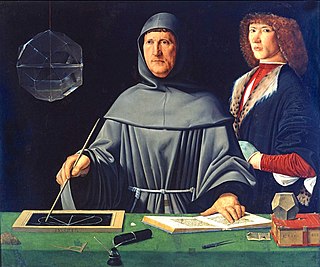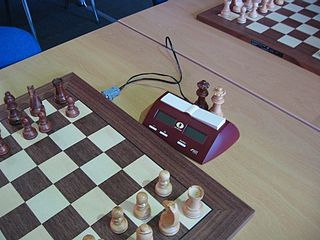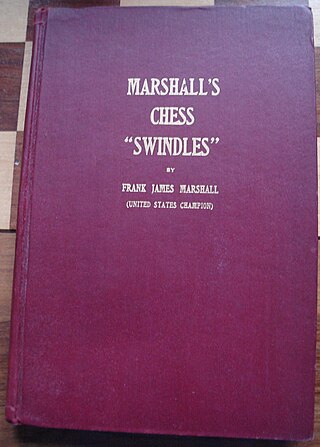
Chess is a board game for two players. It is sometimes called international chess or Western chess to distinguish it from related games such as xiangqi and shogi.

Luca Bartolomeo de Pacioli, O.F.M. was an Italian mathematician, Franciscan friar, collaborator with Leonardo da Vinci, and an early contributor to the field now known as accounting. He is referred to as the father of accounting and bookkeeping and he was the first person to publish a work on the double-entry system of book-keeping on the continent. He was also called Luca di Borgo after his birthplace, Borgo Sansepolcro, Tuscany.
The endgame is the final stage of a chess game which occurs after the middlegame. It begins when few pieces are left on the board.
In the game of chess, an endgame study, or just study, is a composed position—that is, one that has been made up rather than played in an actual game—presented as a sort of puzzle, in which the aim of the solver is to find the essentially unique way for one side to win or draw, as stipulated, against any moves the other side plays. If the study does not end in the end of the game, then the game's eventual outcome should be obvious, and White can have a selection of many different moves. There is no limit to the number of moves which are allowed to achieve the win; this distinguishes studies from the genre of direct mate problems. Such problems also differ qualitatively from the very common genre of tactical puzzles based around the middlegame, often based on an actual game, where a decisive tactic must be found.
Stalemate is a situation in chess where the player whose turn it is to move is not in check and has no legal move. Stalemate results in a draw. During the endgame, stalemate is a resource that can enable the player with the inferior position to draw the game rather than lose. In more complex positions, stalemate is much rarer, usually taking the form of a swindle that succeeds only if the superior side is inattentive. Stalemate is also a common theme in endgame studies and other chess problems.
Andernach chess is a chess variant in which a piece making a capture changes colour. For instance, if a white bishop on a2 were to capture a black knight on g8, the result would be a black bishop on g8. Non-capturing moves are played as in orthodox chess. If a pawn captures on eighth rank, it is promoted first and then changes colour.

The Vitruvian Man is a drawing by the Italian Renaissance artist and scientist Leonardo da Vinci, dated to c. 1490. Inspired by the writings of the ancient Roman architect Vitruvius, the drawing depicts a nude man in two superimposed positions with his arms and legs apart and inscribed in both a circle and square. It was described by the art historian Carmen C. Bambach as "justly ranked among the all-time iconic images of Western civilization". Although not the only known drawing of a man inspired by the writings of Vitruvius, the work is a unique synthesis of artistic and scientific ideals and often considered an archetypal representation of the High Renaissance.

Checkmate is any game position in chess and other chess-like games in which a player's king is in check and there is no possible escape. Checkmating the opponent wins the game.

In chess, promotion is the replacement of a pawn with a new piece when the pawn is moved to its last rank. The player replaces the pawn immediately with a queen, rook, bishop, or knight of the same color. The new piece does not have to be a previously captured piece. Promotion is mandatory when moving to the last rank; the pawn cannot remain as a pawn.
In chess, a half-open file is a file with pawns of only one color. The half-open file can provide a line of attack for a player's rook or queen. A half-open file is generally exploited by the player with no pawns on it.
In chess, a fortress is an endgame drawing technique in which the side behind in material sets up a zone of protection that the opponent cannot penetrate. This might involve keeping the enemy king out of one's position, or a safe zone the enemy cannot force one out of. An elementary fortress is a theoretically drawn position with reduced material in which a passive defense will maintain the draw.
A joke chess problem is a puzzle in chess that uses humor as an element. Although most chess problems, like other creative forms, are appreciated for serious artistic themes, joke chess problems are enjoyed for some twist. In some cases the composer plays a trick to prevent a solver from succeeding with typical analysis. In other cases, the humor derives from an unusual final position. Unlike in ordinary chess puzzles, joke problems can involve a solution which violates the inner logic or rules of the game.

In chess, a swindle is a ruse by which a player in a losing position tricks their opponent and thereby achieves a win or draw instead of the expected loss. It may also refer more generally to obtaining a win or draw from a clearly losing position. I. A. Horowitz and Fred Reinfeld distinguish among "traps", "pitfalls", and "swindles". In their terminology, a "trap" refers to a situation where players go wrong through their own efforts. In a "pitfall", the beneficiary of the pitfall plays an active role, creating a situation where a plausible move by the opponent will turn out badly. A "swindle" is a pitfall adopted by a player who has a clearly lost game. Horowitz and Reinfeld observe that swindles, "though ignored in virtually all chess books", "play an enormously important role in over-the-board chess, and decide the fate of countless games".

Chess became a source of inspiration in the arts in literature soon after the spread of the game to the Arab World and Europe in the Middle Ages. The earliest works of art centered on the game are miniatures in medieval manuscripts, as well as poems, which were often created with the purpose of describing the rules. After chess gained popularity in the 15th and 16th centuries, many works of art related to the game were created. One of the best-known, Marco Girolamo Vida's poem Scacchia ludus, written in 1527, made such an impression on the readers that it singlehandedly inspired other authors to create poems about chess.

Minichess is a family of chess variants played with regular chess pieces and standard rules, but on a smaller board. The motivation for these variants is to make the game simpler and shorter than standard chess. The first chess-like game implemented on a computer was the 6×6 chess variant Los Alamos chess. The low memory capacity of early computers meant that a reduced board size and a smaller number of pieces were required for the game to be implementable on a computer.
The Göttingen manuscript is the earliest known work devoted entirely to modern chess. It is a Latin text of 33 pages held at the University of Göttingen. A quarto parchment manuscript of 33 pages, ff. 1–15a are a discussion of twelve chess openings, f. 16 is blank, and ff. 17–31b are a selection of thirty chess problems, one on each page with a diagram and solution. Authorship and exact date of the manuscript are unknown. Similarities to Lucena's Repeticion de Amores e Arte de Axedres con CL iuegos de partido have led some scholars to surmise that it was written by Lucena or that it was one of Lucena's sources. Although the manuscript is generally assumed to be older than Lucena's work, this is not established. The manuscript has been ascribed possible writing dates of 1500–1505 or 1471.

Divina proportione, later also called De divina proportione is a book on mathematics written by Luca Pacioli and illustrated by Leonardo da Vinci, completed by February 9th, 1498 in Milan and first printed in 1509. Its subject was mathematical proportions and their applications to geometry, to visual art through perspective, and to architecture. The clarity of the written material and Leonardo's excellent diagrams helped the book to achieve an impact beyond mathematical circles, popularizing contemporary geometric concepts and images.

In chess, several checkmate patterns occur frequently enough to have acquired specific names in chess commentary. By definition, a checkmate pattern is a recognizable/particular/studied arrangements of pieces that delivers checkmate. The diagrams that follow show these checkmates with White checkmating Black.

The Portrait of Luca Pacioli is a painting attributed to the Italian Renaissance artist Jacopo de' Barbari, dating to around 1500 and housed in the Capodimonte Museum, Naples, southern Italy. The painting portrays the Renaissance mathematician Luca Pacioli and may have been painted by his collaborator Leonardo da Vinci. The person on the right has not been identified conclusively, but could be the German painter Albrecht Dürer, whom Barbari met between 1495 and 1500.

Summa de arithmetica, geometria, proportioni et proportionalita is a book on mathematics written by Luca Pacioli and first published in 1494. It contains a comprehensive summary of Renaissance mathematics, including practical arithmetic, basic algebra, basic geometry and accounting, written for use as a textbook and reference work.












